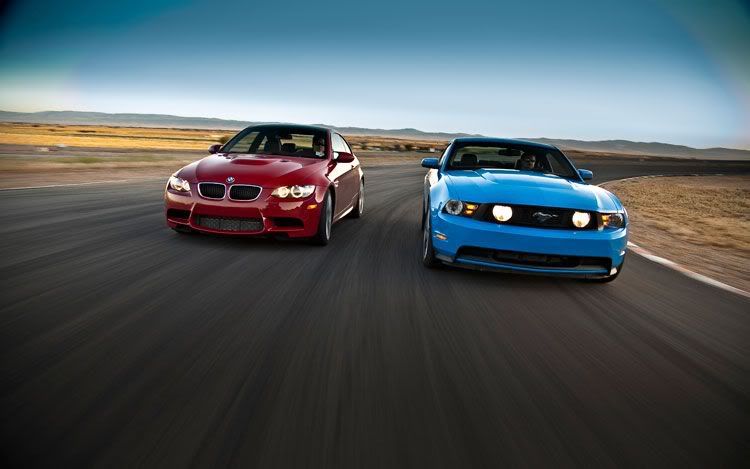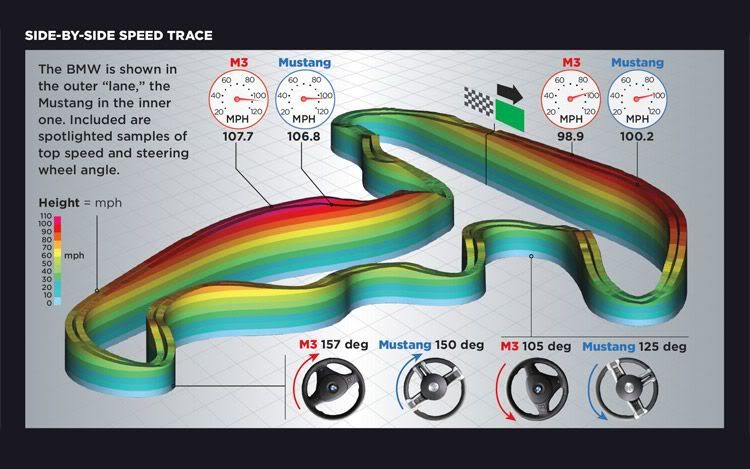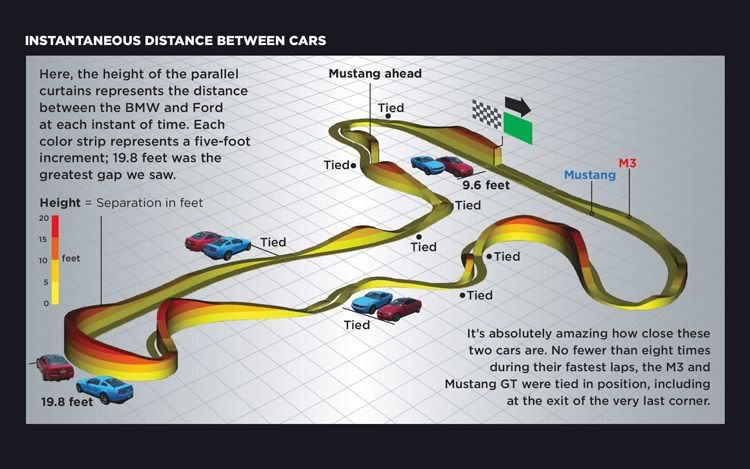Comparison: 2011 Ford Mustang GT vs. 2011 BMW M3 Coupe
No, We're Not Kidding
From the October, 2010 issue of Motor Trend / By Ed Loh / Photography by Brian Vance
"Now are you high or just stupid? An M3 against a Mustang GT? On a racetrack? Seriously, son, which one is it? High or stupid?"
Yes, we know how this sounds. And had we suggested this matchup just a few months ago, we would deserve more withering scorn than can found in a week long Judge Judy marathon.
Why? Because this Munich versus Motown matchup has never been done before. Not even considered because it just didn't make sense. Sure, the M3 went V-8 in 2008, but that's not the issue. The truth is, the Mustang GT was never good enough to challenge Bavaria's finest. That is, until now.
Your doubt is understandable, but check the specs. For 2011, both rear-drive, four-seat coupes use all-aluminum V-8 engines with double-overhead camshafts tickling 32 valves. The M3's 4.0-liter carryover makes 414 horsepower at 8300 rpm and 295 pound-feet of torque at 3900 rpm. The Mustang's all new 5.0-liter V-8 cranks out 412 ponies at 6500 rpm and 390 pound-feet at 4250 rpm. But the most compelling number is 0.2: the difference in power-to-weight ratio between the two. The Mustang carries 8.8 pounds per pony to the M3's 8.6. And yet, at the test track, the 5.0 equals or betters the M3 in every performance category we measure. Both hit 60 mph in 4.4 seconds, but the Mustang is faster to the quarter mile by a tenth of a second and 0.7 mph-12.7 seconds at 111.6 mph. It also stops two feet shorter from 60 mph-a tie as far as we're concerned-and the GT really shatters the M myth on the skidpad. America's original ponycar manages to outgrip one of Germany's most iconic sports cars to the tune 0.2 second through our figure eight and by 0.01 g in lateral acceleration.
But the M3 is the better driving car, right? What about the vaunted BMW steering feel, cornering agility, and legendary suspension tuning? Sure, the Mustang's antiquated live rear axle is fine at the strip (and skidpad, apparently), but the M3 must be faster where it counts: on a racetrack, against the clock. Well, hold onto your buts (and butts), because we are about to find out.
To keep things fair, we spec a brand-new 2011 M3 Coupe with only 1300 miles on the clock. It comes with all the extra goodies that make the M3 a world-class tourer, but the option that most interests us is the new Competition Package. This $2500 kit provides a slightly wider track via higher offset 19-inch wheels and improved grip by way of stickier tires and suspension lowered 0.4 inch. Combined with revisions to the M3's electronic damping control (EDC) and dynamic stability control (DSC) systems, BMW claims the Competition Package-equipped M3 is "the best-handling production M vehicle ever built." Hmmm, hope they mean on a racetrack...
To meet this challenge, we ask Ford to send us a 2011 Mustang GT Premium with optional 3.73 gears ($395) and Brembo brake package ($1695). We also request nearly all the luxury options available (except the glass roof, for weight reasons) to make it a comparable GT. This explains the fancy stripes on the leather seats, HID headlamps, and Sync-based infotainment system.
Despite all the box checking, the only thing we can't equalize is the price. In fact, the chasm between the $67,025 M3 and $40,275 Mustang GT can easily be filled with, well, another Mustang.
Ah, but is it worth it? That's the $26,750 question, and for the answer, we implement a plan cribbed from basic cable. Behold, Mustang versus M3, "Pros vs. Joes"-style.
The concept is this: To definitively determine which car is faster is relatively easy. We rent the 1.8-mile Streets of Willow Springs road course and employ the services of Randy Pobst, the very same championship-winning pro driver we use for our semi-annual Best Driver's Car showdown. Not only can Randy extract the fastest lap from anything with four wheels, he can tell you why it's so fast. To determine which car is better in the hands of the common man, well, that's this Joe's job.
To keep things safe (for me) and fast (for Randy), we lap separately and with slightly different setups. I go out first, with all the traction and stability controls engaged, but set to the sportiest settings. A bit of yaw is available via Ford's AdvanceTrac and BMW's M-Drive system, but not so much that I could end up backwards in the tire barrier (known to happen). For those playing at home, that means I hit the Mustang's traction control button once to put it in Sport mode. For the M3, I set throttle response to SportPlus, Servotronic steering and EDC to Sport, and DSC to M-dynamic mode.
Randy's setup is far simpler: Just turn everything off and get the hell out of his way.
So which is faster? We didn't tell Randy until the very end, so we won't tell you yet, either. This is called dramatic tension, and it's created by discussing the relative merits of each vehicle -- Mustang first.
That the 5.0 will lay two sets of stripes out of every corner isn't the surprise, it's how clean and in control the car feels while doing it. Another shocker is how hard it dives when those four-piston Brembo calipers bite down.
"The car stands on its nose when you go to brake," says Randy, "And there's a fair amount of squat, so you feel a lot of pitch. It doesn't seem to be hurting the cars braking or entry that much, but it's disconcerting."
We both found the 5.0-liter responsive and fantastic, but split on the six-speed manual. Rev-matching the rumbling V-8 is easy for me, but surprisingly, Randy can't be bothered. "I just skipped second. The shifts take so long that with the torque curve from the V-8 engine, it's better to just leave it in third gear," he says. "It comes out of these tighter corners at about 4000 rpm and it pulls!"






 Reply With Quote
Reply With Quote




Bookmarks